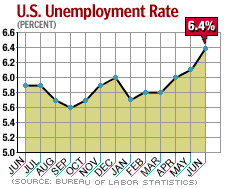NEW YORK (CNN/Money) -
Two years ago, the U.S. economy was just entering its third -- and probably last -- quarter of recession, and the unemployment rate was just beginning to climb.
Two years later, the jobless rate is still climbing.
In fact, U.S. unemployment rose to its worst level in nine years in June as businesses cut thousands of jobs, the government said Thursday.

Unemployment rose to 6.4 percent from 6.1 percent in May. That's the highest level since April 1994. Economists on average had expected a jobless rate of 6.2 percent, according to a Reuters poll.
In addition, non-farm payrolls fell by 30,000 jobs for the month, the report said, after losing a revised 70,000 jobs in May.
Payrolls have fallen year-over-year for 23 straight months, according to Labor Department data, extending the worst stretch for the labor market since World War II.
Usually, by this point in the recession-recovery cycle, the jobless rate should be on its way back down. The last time it rose two years after the last quarter of a recession was in 1982, when the economy was just climbing out of a deep, prolonged slump.
Today's economy, too, seems to be climbing out of its own slump -- but it probably won't be enough to create many new jobs any time soon.
"We're looking for increases in employment, but because the labor force is growing 1 percent a year, we need 125,000 new jobs per month to stabilize the unemployment rate," said Mickey Levy, chief economist at Bank of America and one of the best economic forecasters of the past 17 years, according to a recent Federal Reserve study. "We see the unemployment rate drifting slightly higher and lingering higher for the next year."
The real unemployment picture
And the unemployment rate, though relatively low by historical standards, may actually understate the labor market's woes.
For one thing, many unemployed people have simply quit looking for work, meaning they are not counted as part of the "labor force" and thus are not counted in the Labor Department's calculation of the unemployment rate. If the economy improves, many of these "discouraged" workers -- 482,000, by the department's last count -- will likely start looking for work again, and the unemployment rate will rise.
| Related stories
|

|
|
|
|
Meanwhile, 1.9 million people have been unemployed 27 weeks or more, meaning many of them have exhausted their unemployment benefits. According to research by Anthony Chan, chief economist at Banc One Investment Advisors, 43.2 percent of all unemployed workers have exhausted their benefits -- the highest rate in more than three decades.
"Despite the fact that the unemployment rate remains low relative to prior economic downturns, the burden on the unemployed population has been the most severe, by one measure, since at least 1972," Chan said.
Furthermore, many of the people who do have jobs are working only part-time. According to the Labor Department, if you add all the workers "marginally attached" to the labor force -- out of work and not looking for work -- to all those working part-time and those unemployed and looking for work, the unemployment rate rises to 9.7 percent.
Not included in this group are the untold number of people who have had to take lower-paying jobs because they can't find work in their chosen profession. That trend, combined with all the slack in the labor market, has conspired to slow wage growth. That, in turn, could hurt consumer spending, which fuels more than two-thirds of the world's largest economy.
Lost signs of a rebound?
There had been some hopeful signs for the labor market lately, with new claims for unemployment benefits shrinking to just above 400,000, the benchmark level indicating labor market weakness.
And monthly job-cut announcements tracked by Chicago outplacement firm Challenger Gray & Christmas fell in June to their lowest level in 31 months.
However, these numbers simply mean that employers have finally stopped cutting jobs. They've yet to show any inclination to hire more workers.
In its latest report , weekly unemployment claims Thursday spiked to 430,000 in the week ended June 28, from a revised 409,000 the prior week, and much higher than economists' forecasts for 412,000 new claims.
"U.S. employers are still void of the business confidence needed to increase their employment projections for the third quarter," Manpower Inc.'s CEO Jeffrey Joerres said last month. "Employers have expressed uncertainty in hiring intentions in recent Manpower Employment Outlook Surveys, but this quarter represents the weakest job outlook in 12 years."
The Manpower Inc. survey of the third-quarter hiring plans of 16,000 U.S. employers showed only 20 percent planned to add workers -- a lower percentage than the second quarter, and lower than the third quarter of 2002.
And a Conference Board survey of help-wanted advertising showed job listings fell in eight of nine regions, and the private research group's "Help Wanted Index" was lower than it was a year ago.
"Consumer spending remains the mainstay of this weak economic recovery. With tax cuts enacted, the consumer is likely to continue hanging in there," said Conference Board economist Ken Goldstein. "But a real recovery, including a slowdown in layoffs and the opening of new jobs, is far more dependent on recovery in (business) investment than on stronger consumption growth."

|

